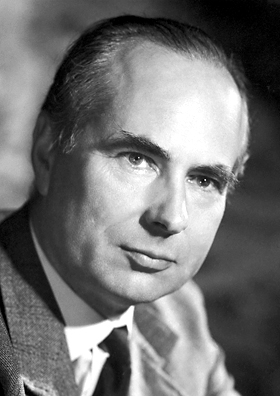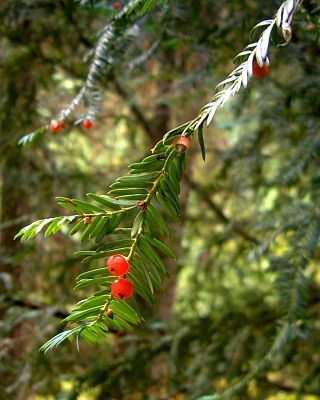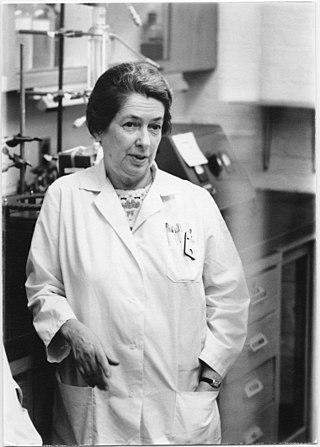Related Research Articles

Dorothy Mary Crowfoot Hodgkin was a Nobel Prize-winning English chemist who advanced the technique of X-ray crystallography to determine the structure of biomolecules, which became essential for structural biology.

Sir Andrew Fielding Huxley was an English physiologist and biophysicist. He was born into the prominent Huxley family. After leaving Westminster School in central London, he went to Trinity College, Cambridge, on a scholarship, after which he joined Alan Hodgkin to study nerve impulses. Their eventual discovery of the basis for propagation of nerve impulses earned them the Nobel Prize in Physiology or Medicine in 1963. They made their discovery from the giant axon of the Atlantic squid. Soon after the outbreak of the Second World War, Huxley was recruited by the British Anti-Aircraft Command and later transferred to the Admiralty. After the war he resumed research at the University of Cambridge, where he developed interference microscopy that would be suitable for studying muscle fibres.

Strychnine is a highly toxic, colorless, bitter, crystalline alkaloid used as a pesticide, particularly for killing small vertebrates such as birds and rodents. Strychnine, when inhaled, swallowed, or absorbed through the eyes or mouth, causes poisoning which results in muscular convulsions and eventually death through asphyxia. While it is no longer used medicinally, it was used historically in small doses to strengthen muscle contractions, such as a heart and bowel stimulant and performance-enhancing drug. The most common source is from the seeds of the Strychnos nux-vomica tree.
The year 1957 in science and technology involved some significant events, listed below.

Sir John Cowdery Kendrew, was an English biochemist, crystallographer, and science administrator. Kendrew shared the 1962 Nobel Prize in Chemistry with Max Perutz, for their work at the Cavendish Laboratory to investigate the structure of haem-containing proteins.

The year 1945 in science and technology involved some significant events, listed below.
The year 1946 in science and technology involved some significant events, listed below.
The year 1984 in science and technology involved some significant events.
The year 1960 in science and technology involved some significant events, listed below.
The year 1956 in science and technology involved some significant events, listed below.
The year 1955 in science and technology included many events, some of which are listed below.
The year 1952 in science and technology involved some significant events, listed below.
Total synthesis, a specialized area within organic chemistry, focuses on constructing complex organic compounds, especially those found in nature, using laboratory methods. It often involves synthesizing natural products from basic, commercially available starting materials. Total synthesis targets can also be organometallic or inorganic. While total synthesis aims for complete construction from simple starting materials, modifying or partially synthesizing these compounds is known as semisynthesis.

Sir Robert Robinson was a British organic chemist and Nobel laureate recognised in 1947 for his research on plant dyestuffs (anthocyanins) and alkaloids. In 1947, he also received the Medal of Freedom with Silver Palm.

A natural product is a natural compound or substance produced by a living organism—that is, found in nature. In the broadest sense, natural products include any substance produced by life. Natural products can also be prepared by chemical synthesis and have played a central role in the development of the field of organic chemistry by providing challenging synthetic targets. The term natural product has also been extended for commercial purposes to refer to cosmetics, dietary supplements, and foods produced from natural sources without added artificial ingredients.
Organic synthesis is a branch of chemical synthesis concerned with the construction of organic compounds. Organic compounds are molecules consisting of combinations of covalently-linked hydrogen, carbon, oxygen, and nitrogen atoms. Within the general subject of organic synthesis, there are many different types of synthetic routes that can be completed including total synthesis, stereoselective synthesis, automated synthesis, and many more. Additionally, in understanding organic synthesis it is necessary to be familiar with the methodology, techniques, and applications of the subject.

Narinder Singh Kapany was an Indian-American physicist best known for his work on fiber optics. Kapany is a pioneer in the field of fiber optics, known for coining and popularising the term. Fortune named him one of seven "Unsung Heroes of the 20th Century" for his Nobel Prize-deserving invention. He was awarded India's second highest civilian award, the Padma Vibhushan, posthumously in 2021. He served as an Indian Ordnance Factories Service (IOFS) officer. He was also offered the post of Scientific Adviser to the Defence Minister of India, by the first Prime Minister of India, Jawaharlal Nehru. He is considered the father of Fiber Optics.

Gertrude Erika Perlmann was an Austro-Hungarian Empire-born U.S. biochemist and structural biologist. She is known for her work in protein chemistry, particularly her discoveries on the biology of phosphoproteins and the structure and action of pepsin and pepsinogen.
Satinder Vir Kessar is an Indian synthetic organic chemist, academic and an Emeritus professor of Panjab University. He is known for his researches in steroidal and heterocyclic chemistry. He is an elected fellow of The World Academy of Sciences and all the three major Indian science academies, viz. The Indian National Science Academy, the Indian Academy of Sciences and the National Academy of Sciences, India. The Council of Scientific and Industrial Research, the apex agency of the Government of India for scientific research, awarded him the Shanti Swarup Bhatnagar Prize for Science and Technology, one of the highest Indian science awards, in 1972, for his contributions to chemical sciences.
Joan P. Folkes was a scientist who was nominated for the Nobel Prize in chemistry in 1956. Along with Ernest Gale, she demonstrated that nucleic acids have an organizing or controlling role in protein synthesis. In his 2005 book, Hans-Jörg Rheinberger discussed the work of Folkes and Gale and how they revealed a connection between the levels of nucleic acids in cells and the rate that proteins were made.
References
- ↑ Dement'yev and Rustamov (1985). The Red Data Book of Turkmenistan. Ashgabat: Turkmenistan Publishing House.
- ↑ Arnon, Daniel I.; Allen, Mary B.; Whatley, F. R. (1954). "Photosynthesis by Isolated Chloroplasts". Nature . 174 (4426): 394–6. Bibcode:1954Natur.174..394A. doi:10.1038/174394a0. PMID 13194001. S2CID 2462316.
- ↑ Laurence, William L. (December 30, 1954). "Sun is Harnessed to Create Food: Science Team on the Coast Duplicates Photosynthesis Outside Plants' Cells". The New York Times. Retrieved July 18, 2010.
- ↑ de Waal, Frans B. M., ed. (2002). Tree of Origin: What Primate Behavior Can Tell Us About Human Social Evolution . Cambridge, Mass: Harvard University Press. p. 51. ISBN 0-674-00460-4.
- ↑ Brink, Clara; Hodgkin, Dorothy Crowfoot; Lindsey, June; Pickworth, Jenny; Robertson, John H.; White, John G. (December 25, 1954). "X-ray Crystallographic Evidence on the Structure of Vitamin B12". Nature . 174 (4443): 1169–117. Bibcode:1954Natur.174.1169B. doi:10.1038/1741169a0. PMID 13223773. S2CID 4207158.
- ↑ Glusker, Jenny P. (1994). "Dorothy Crowfoot Hodgkin (1910–1994)". Protein Science . 3 (12): 2465–2469. doi:10.1002/pro.5560031233. PMC 2142778 . PMID 7757003.
- ↑ Nicolaou, K. C.; Sorensen, E. J. (1996). Classics in Total Synthesis: Targets, Strategies, Methods. Wiley. ISBN 978-3-527-29231-8.
- ↑ Nicolaou, K. C.; Vourloumis, Dionisios; Winssinger, Nicolas; Baran, Phil S. (2000). "The Art and Science of Total Synthesis at the Dawn of the Twenty-First Century". Angewandte Chemie International Edition . 39 (1): 44–122.
{{cite journal}}: CS1 maint: multiple names: authors list (link) - ↑ Bonjoch, Josep; Sole, Daniel (2000). "Synthesis of Strychnine". Chemical Reviews . 100 (9): 3455–3482. doi:10.1021/cr9902547. PMID 11777429.
- ↑ Proudfoot, John R. (2013). "Reaction Schemes Visualized in Network Form: The Syntheses of Strychnine as an Example". Journal of Chemical Information and Modeling. 53 (5): 1035–1042. doi:10.1021/ci300556b. PMID 23597302.
- ↑ Irvine, M. M. (2001). "Early Digital Computers at Bell Telephone Laboratories". IEEE Annals of the History of Computing. 23 (3): 22–42. doi:10.1109/85.948904 . Retrieved June 7, 2009.
- ↑ "Benstonite". Mindat. Retrieved December 31, 2012.
- ↑ No. 2,950,048.
- ↑ Roth, K. F. (1954). "On irregularities of distribution". Mathematika . 1 (2): 73–79. doi:10.1112/S0025579300000541. MR 0066435.
- ↑ Doll, Richard (1955). "Mortality from lung cancer in asbestos workers". British Journal of Industrial Medicine. 12 (6): 81–6. doi:10.1136/oem.50.6.485. PMC 1035472 . PMID 8329311.
- ↑ "Donor Of First Successful Organ Transplant Dies 56 Years Later". The Huffington Post . December 29, 2010. Retrieved March 15, 2011.
- ↑ Stämpfli, R. (1954). "A new method for measuring membrane potentials with external electrodes". Experientia . 10 (12): 508–509. doi:10.1007/BF02166189. PMID 14353097. S2CID 41384989.
- ↑ Akert, K. (August 1996). Swiss Contributions to the Neurosciences in Four Hundred Years: From the Renaissance to the Present. Verlag der Fachvereine Hochschulverlag AG an der ETH Zurich. ISBN 978-3728123626.
- ↑ Hopkins, H. H.; Kapany, N. S. (1954). "A flexible fibrescope, using static scanning". Nature . 173 (4392): 39. Bibcode:1954Natur.173...39H. doi:10.1038/173039b0. S2CID 4275331.
- ↑ "1954: foundations for European science". CERN. 2008. Retrieved February 28, 2011.
- ↑ Reshetov, V. (November 13, 2013). "An ocean of energy" (in Russian). Archived from the original on November 13, 2013.
- ↑ Sherif, M.; Harvey, O. J.; White, B. J.; Hood, W.; Sherif, C. W. (1961). Intergroup Conflict and Cooperation: The Robbers Cave Experiment . Norman, Oklahoma: University Book Exchange.
- ↑ "Nuclear Power in Russia". World Nuclear Association. December 2011. Archived from the original on February 13, 2013. Retrieved December 16, 2011.
- ↑ U.S. patent 2,682,235.
- ↑ Bundy, F. P.; Hall, H. T.; Strong, H. M.; Wentorf, R. H. (1955). "Man-made diamonds" (PDF). Nature. 176 (4471): 51–55. Bibcode:1955Natur.176...51B. doi:10.1038/176051a0. S2CID 4266566. Archived from the original (PDF) on January 8, 2014.
- ↑ "Sir William Hamilton OBE". HamiltonJet. 2007. Retrieved November 12, 2012.
- ↑ "Sixty years of the Federal Republic of Germany – a retrospective of everyday life". Archived from the original on February 25, 2021. Retrieved December 28, 2002.
- ↑ "Staley McBrayer, 92; Inventor of Offset Press for Newspaper Printing". Los Angeles Times . April 18, 2002. Retrieved October 19, 2017.
- ↑ "Press release: The Nobel Prize in Chemistry 2022" (Press release). The Nobel Prize. October 5, 2022. Retrieved October 6, 2022.
- ↑ "Alan Turing | Biography, Facts, & Education". Encyclopædia Britannica . Retrieved February 14, 2020.